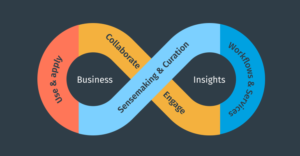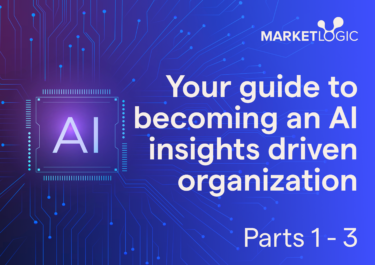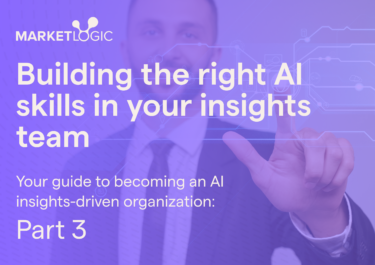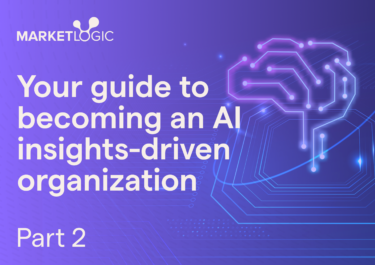
October 21, 2021

October 21, 2021
If there’s one thing you can take away from our recent Insights Executive Roundtable, it’s this: future growth depends on business and insights teams closely collaborating to build a capability that makes winning decisions.
Insights executives from Philips, Mondelēz, and Colgate-Palmolive shared their perspectives on what that looks like in their discussion – a discussion Market Logic’s Stefan Ropers, CEO, made sure to frame as a joint learning journey (versus providing all the answers).
This process-oriented insights journey was a running theme throughout the discussion as participants shared their perspectives on questions like, “What’s the connection between insights, decisions, and growth?”, “How do you avoid growing numbers of contradictory insights in the process of scaling?”, and “What’s a good step towards more effective stakeholder communication?”
In his keynote, Stefan offered these three key ideas when considering what it means to build an effective insights-to-decisions capability:
Actionable insights require strong partnerships with the business
Your insights organization has a tricky role to play. With so few insights professionals to business stakeholders (1 to 100 in some cases), combined with exponential knowledge growth (i.e., the knowledge doubling curve), an insights function has to find the balance between close collaboration with stakeholders who are strategy-aligned and servicing the burning questions of every business stakeholder in the company.
For Stuart McGown, Head of Marketing Insights & Analytics at Philips, it’s critical for your insights teams to be clear who your decision makers are, understand them, and be very clear about the impact you want to make. “Focus on the primary stakeholders with a business-partner type of model, and then at the same time find ways to really democratize information and get it into the hands of people at scale otherwise,” Stuart said.
Christian Niederauer, Director Strategic Insights & Consumer Affairs, Europe at Colgate-Palmolive, agreed. He said it’s important to build business IQ and acumen as a function, so you can align insights in a way that’s most impactful. Then, you can use your insights platform’s tools to field questions at scale, freeing your time to focus on developing the most impactful insights, and in turn, influencing better decision making and helping your company grow and flourish.
At the same time, agility in insights is about being flexible and responding to the business’s needs and strategy, not the peaks and valleys of a particular team. “We really have to know the business and then find our best structure around it, not just follow other functions,” Christian said.
Paola Vacchini, Director Consumer Insights Analytics at Mondelēz, connected this idea to a fundamental shift in insights – from reaction to proactive anticipation – the magic sweet spot where your team is able to anticipate your stakeholders’ future questions.
“We try to empathize with people and how they’re making decisions, then decide what is the role we want to play,” Paola said.
Building insights-to-decisions capability: a continuous feedback loop
For Paola, change management is just as important as tools and technology in building capabilities, ensuring that when building your capability, you’re building it from an approach of continuous improvement.
“There’s no doubt we need to have tools and make them available to everybody. But it’s really important we also pay attention to the change management piece. What has to happen so that people are adopting these new tools and capabilities in their everyday life? And being really open and transparent, to get the feedback to understand what’s working, what’s not working and improve them. Going into this mindset of customer centricity for our capability to receive feedback and go into an approach of continuous improvement.”
Stuart linked this change management approach back to Market Logic’s visual – the four-part insights-driven-decisions capability.

“It’s not a start and a finish. It’s always changing and evolving … I think it’s an infinite change loop that we’re in and it’s the continuous sort of evolution that we’re on.”
Christian added, change management is about continuous change, not another digital transformation or revolution, especially because the future is moving so fast and business capabilities have to match that pace.
For Market Logic, the infinity loop visualizes a highly productive and technology-enabled insights organization that engages with the business in a very collaborative kind of way, supported with sensemaking and curation. The business can easily use and apply these insights to support better decisions, then provide feedback to improve the deliverables of the insights organization.
“If a sustainable infinity loop like that can be put in place in a partnership with the business, the organization in our view is laying a foundation for a new business capability, improving decision making, which in turn should support growth,” Stefan said.
Don’t miss out on the other topics covered during this roundtable
Executives from Colgate-Palmolive, Mondelēz, and Philips shared much more during this chapter of our roundtable series, including topics like:
Don’t miss out on this fascinating in-depth discussion! Register here to watch the full recording.

How is AI transforming roles, skills and capabilities in insights functions?

Interview with Nextatlas CEO Luca Morena

An introduction to gen AI for businesses. From RAG to LLMs — get the lowdown.

Exploring the Future of AI in Marketing: Integrating Insights into Business Systems for Enhanced Decision-Making.

To succeed in today's dynamic consumer landscape, your organization must be able to react faster…

How does this guide help you? In part 3 of our guide, we’ll delve into…

Learn the AI insights-powered enterprise systems architecture and processes.

Transform your organization with insights. Download this guide to find out how.